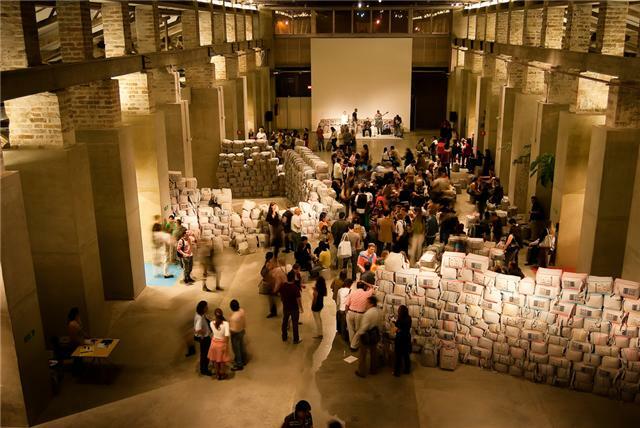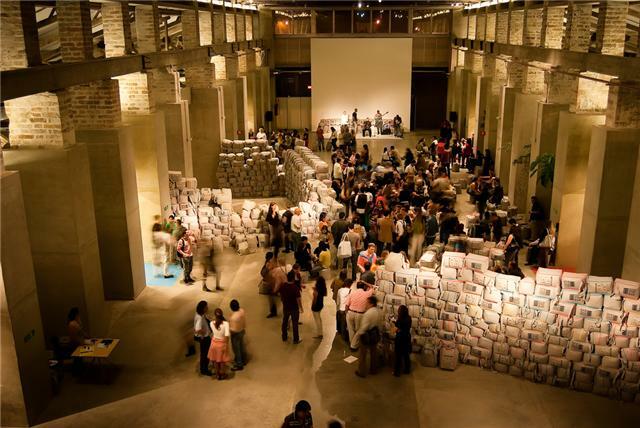New Headquarters of the Museum of Modern Art in Medellin, Colombia
The Museum of Modern Art of Medellin (Museo de Arte Moderno de Medellín MAMM), opened its new headquarters to the public this last November. The building, built originally in the 1930s as part of a steel factory, was restored and made a museum with an investment of more than two million dollars. The project was financed with the help of private industry (eighty percent) and the municipal administration (twenty percent). The new headquarters is located in what once was the industrial sector of the city, and is a central part of a big Project of urban re-zoning that will include residential zones, commercial areas and parks. The architecture program (area 2,900 m2) duplicates the exhibition areas of the original museum, and includes: a room for large works, a room for permanent collections, a room for traveling collections, a room for special projects, a gift shop and a restaurant. The museum also counts with an external space that the institution will use for the installation of public events. The new building meets the international museum standard and is prepared to occupy a space without precedence in the national and international level, focusing on “forming the public in the contemporary art practices” through exhibition programs in art, architecture, design, fashion, film and other media.

For this year MAMM has began an exhibition program with a new retrospective collection by the Belgian artist Jan Fabre. From February 17th to April 25th, the museum will install an exhibition called “chronic 1995-2005” that will explore pieces by artists that began the task of transforming the contemporary art scene in Colombia during the decade in the title, and that share in common a strong relation with the sociopolitical context of the country as a response to a period marked by an economic recession, violence, demilitarization, and clashes between the state and guerilla groups. There will be a retrospective outlook from the 5th of May to the 8th of August on the work of the Cuban Artist Carlos Garaicoa, who explores the political ideologists of Cuba through modern architecture. In his installations, the artist uses architectural models, photography, drawings and videos to articulate de flawed model of the social and urban programs of his country. From October 11th and ending in November 7th the exhibition and cycle of conferences of the VII Ibero-american Biennial of Architecture and Urbanism, which will take on the notion of “Architecture with Values”, will be installed.
The MAMM was funded as an private entity in 1978 by a group of artists, architects and other contributors as a response to the art biennials that were realized in Medellin until 1981. Today, the museum has more than 5,000 works from artists like Manuel Hernandez, Beatriz Gonzales, Olga de Amaral, Carlos Cruz-Díez, Eduardo Ramírez Villamizar, Débora Arango, among others, and defines itself as a “space of citizen participation, an educational tool for the public and the live archive of the history of contemporary art in Medellin”. Juliana Restrepo, the museum director affirms that thanks to the help of the municipal administration that allows visitors free access, it has been possible to organize a great number of exhibitions and educative programs that have exponentially elevated the number of visitors. In 1008 particularly, the number of visitors grew to more than 170,000 compared to less than ten thousand the previous year. Without doubt, the MAMM will become, with this new location and a project of expansion planned for next year, one of the best and most visited museums in the country.
The expansion project contemplates the construction of an adjacent building that will include a library specialized in the arts, additional exhibition rooms, an auditorium, formation workshops, administrative areas and guest services. On December 2009, the museum chose a proposal out of eleven that were presented for an international contest in which architects like Rafael Iglesias (Argentina), Enrique Norten (Mexico), Fernando Viegas (Brazil), and Juan Herreros (Spain), and others participated. The chosen proposal was presented by the firm 51-1 Architects based in Peru and formed by César Becerra, Fernando Puente and Manuel de Rivero. The project plans an architectural program of 3500 m2 and is estimated that an investment of more than 8 million dollars is needed for the construction of the new building, of which 2 million will be supplied by municipal administration.
During this new chapter in the history of MAMM, the museum faces great challenges. The first is to recognize the art practices of the city in the contemporary art context. And interpret these expressions with the objective of pluralizing the artistic movements of the region. If the museum is considered a force of great social impact, such impact could only be measured if the museum manages to strengthen the understanding of contemporary and modern art in a community with multiple levels of aesthetic and intellectual formation. More than the index of visitors, it will be the index of participation of these visitors that will serve as an effective measurement instrument. The MAAM, like many other museums around the world, has become a catalyst for the re-zoning of the industrial sectors. In this way, another great challenge for the museum is the compatibility with a new residential sector. Because the zone is located adjacent to the area of greater residential growth in the city, the goal is for the museum to become a major public attraction- according to the article published by Business Week in May 2007, more residential buildings are built in Medellin than in New York and Los Angeles combined. This indicated that the museum has a great advantage, but the challenge of probing the equation right proves the great responsibility that these institutions have for the development of a city in the process of transformation.





